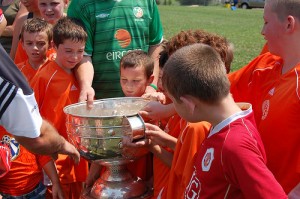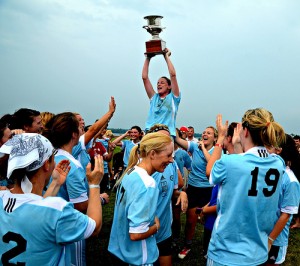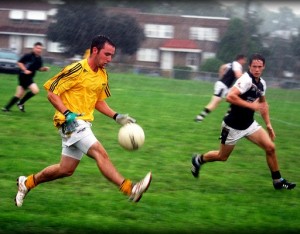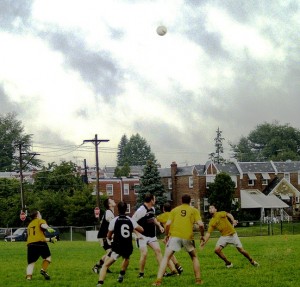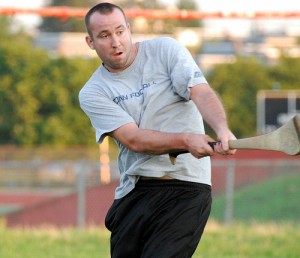
Joe Harrington takes a swing.
It’s a quiet late summer night at Northeast Philadelphia High School. The only sounds are the rubbery whirr of tires as traffic passes by along Algon Avenue, and the occasional “clink” of an aluminum bat as someone gets a hit during a pickup game up on the school’s brightly illuminated baseball diamond.
And down on a hardscrabble pitch just below the diamond, you can hear one other particular noise from time to time, best described as a “clop.” It’s the distinctive sound of the Irish sport known as hurling.
As dusk descends over the city, seven young members of the Philadelphia Shamrocks hurling team are charging up and down the field, attempting to hit a small white ball with a flat-bladed wooden bat. The ball is called a sliotar (pronounced shlitter); the bat, which looks like a giant cheese spreader, is a hurley. As with most field sports, the goal is to drive the ball through a goal. Every time a hurley makes contact with a sliotar: “clop.” (Learn more here.)
A nearly full moon hangs over the field, casting just enough light so that you can make out the shadowy outlines of the players as they charge back and forth. Finally, out of the darkness, there comes a slightly different sounding “clop,” followed by a sharp expletive. In the dark, a player has evidently mistaken another player’s helmet for the ball. The guys quickly huddle around the fallen player to make sure he’s not badly injured. He slowly pulls himself up off his hands and knees, yanks off his helmet and gingerly rubs his sore head. He says he’s OK. With that, they all decide that this would be a good time to end practice.
Hurling has a long history in Ireland. In one form or another, historians say, the game has been played for 2,000 years. And unlike your average American football game, which some historians say lasts about the same number of years, hurling is lightning-fast. Games last 60 minutes, 30 minutes a half, but it’s all over before you know it.
The game is also also a little nuts. It’s brutally physical, a tangle of hardwood sticks and straining limbs locked in a struggle to the death, all to gain control over a tiny ball. Hockey-style body slams aren’t allowed, but maybe the Irish just have a different name for the high-speed collisions that regularly leave players sprawled on the ground like squashed bugs.
Players wear no padding. Helmets were not required until 2010. Hell, it only took 2,000 years.
Naturally, the Irish play this sport beautifully, effortlessly.
For the Shamrocks, though, it’s a different story. When the team formed back in 1985, it was mostly Irish guys out on the field. Now, all but four of the players are Yanks.
The Irish start to learn the sport practically when they’re still in nappies. “We’re not starting to pick it up until we’re in our 20s,” says Shamrocks player Fiachra (FEE-kra) Malone. “We’re at a disadvantage.”
For the American guys, who grew up loving and playing American sports, at least some of the rules and playing techniques of hurling are counter-intuitive.
Joshua Burns, the team PR guy and a regular player, offers a case in point: The way you grasp a hurley. When you hold a baseball bat, your dominant hand is on top, says Burns. With a hurley, it’s the opposite: dominant hand on the bottom.
“You’re reversing everything you thought you knew,” Malone says.
Picking up hurling takes about three years, Burns says. “Your third year is when you’re about as good as you’re gonna get.” And that would be OK except for one thing: high turnover. The longest-tenured Shamrock has been on the team four years.
In spite of the obstacles, the Americans who play for the Shamrocks are fully committed gung-ho types. There are 24 of them altogether, and they’re dedicated to sport, hoping to raise its profile in the local Irish community.
Coach Frank O’Mara, who first started playing the game when he was a 10-year-old boy in Tipperary, thinks he understands why such a rugged, demanding sport might be a draw for Americans.
“They’re at a point where they’re not really playing any kind of organized team sports like they might have done when they were in school,” O’Mara says. “Now they see this new sport as a challenge. It has the eye-hand coordination of baseball, the physical contact of hockey, and it appeals to them.”
If hurling is going to remain a viable concern in the Philadelphia Irish community, it’ll be up to the Americans to make it happen. “We know we either have to appeal to a broader audience, or the club could fold. We’ve always wanted to attract Americans. We’re looking to get everybody we can to come and play.”
The Shamrocks are considering starting a fall league, so now’s a good time to pick up a hurley.
Learn how to play. Visit the Shamrocks’ Web site.

